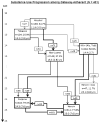Progression to regular heroin use: examination of patterns, predictors, and consequences
- PMID: 25765913
- PMCID: PMC5541382
- DOI: 10.1016/j.addbeh.2015.02.014
Progression to regular heroin use: examination of patterns, predictors, and consequences
Abstract
Background: The present study retrospectively evaluated the chronology and predictors of substance use progression in current heroin-using individuals.
Methods: Out-of-treatment heroin users (urinalysis-verified; N=562) were screened for laboratory-based research studies using questionnaires and urinalysis. Comprehensive substance use histories were collected. Between- and within-substance use progression was analyzed using stepwise linear regression models.
Results: The strongest predictor of onset of regular heroin use was age at initial heroin use, accounting for 71.8% of variance. The strongest between-substance predictors of regular heroin use were ages at regular alcohol and tobacco use, accounting for 8.1% of variance. Earlier onset of regular heroin use (≤20 years) vs. older onset (≥30 years) was associated with a more rapid progression from initial to regular use, longer duration of heroin use, more lifetime use-related negative consequences, and greater likelihood of injecting heroin. The majority of participants (79.7%) reported substance use progression consistent with the gateway hypothesis. Gateway-inconsistent individuals were more likely to be African-American and to report younger age at initial use, longer duration of heroin use, and more frequent past-month heroin use.
Conclusions: Our findings demonstrate the predictive validity and clinical relevance of evaluating substance use chronology and the gateway hypothesis pattern of progression.
Keywords: Gateway hypothesis; Heroin use disorder; Opioid; Substance use progression.
Copyright © 2015. Published by Elsevier Ltd.
Conflict of interest statement
All authors declare no conflict of interest with respect to the conduct or content of this work.
Figures




References
-
- Agrawal A, Scherrer JF, Lynskey MT, Sartor CE, Grant JD, Haber JR, et al. Patterns of use, sequence of onsets and correlates of tobacco and cannabis. Addictive Behaviors. 2011;36(12):1141–1147. http://dx.doi.org/10.1016/j.addbeh.2011.07.005. - DOI - PMC - PubMed
-
- Anthony JC. Death of the ‘stepping-stone’ hypothesis and the ‘gateway’ model? Comments on Morral et al. Addiction. 2002;97(12):1505–1507. - PubMed
-
- Baggio S, Studer J, Mohler-Kuo M, Daeppen JB, Gmel G. Profiles of drug users in Switzerland and effects of early-onset intensive use of alcohol, tobacco and cannabis on other illicit drug use. Swiss Medical Weekly. 2013;143:w13805. http://dx.doi.org/10.4414/smw.2013.13805. - DOI - PubMed
-
- Breslau N, Fenn N, Peterson EL. Early smoking initiation and nicotine dependence in a cohort of young adults. Drug and Alcohol Dependence. 1993;33(2):129–137. http://dx.doi.org/10.1016/0376-8716(93)90054-T. - DOI - PubMed
-
- Brook DW, Brook JS, Zhang C, Cohen P, Whiteman M. Drug use and the risk of major depressive disorder, alcohol dependence, and substance use disorders. Archives of General Psychiatry. 2002;59(11):1039–1044. http://dx.doi.org/10.1001/archpsyc.59.11.1039. - DOI - PubMed
Publication types
MeSH terms
Grants and funding
LinkOut - more resources
Full Text Sources
Other Literature Sources
Medical
Miscellaneous

